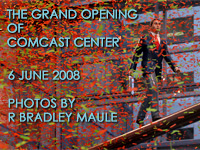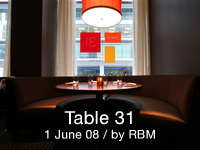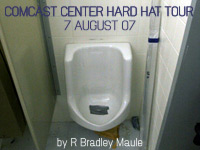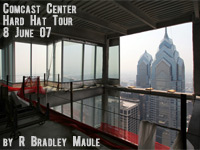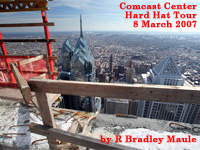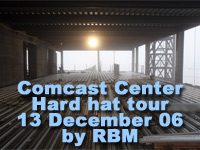|
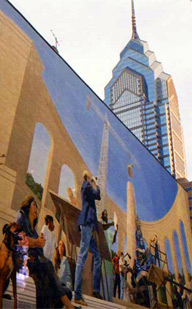 On Saturday, 25th November 2000, this 24 year old kid had finally accepted that his dream job in New York had fallen through, and that there were no dream
jobs in Pittsburgh. In need of a job and some income and a reason to move out of my parents' house in Tyrone, Pennsylvania, I took my friend Bekka up on her offer
of a job here. "Philadelphia will do."
On Saturday, 25th November 2000, this 24 year old kid had finally accepted that his dream job in New York had fallen through, and that there were no dream
jobs in Pittsburgh. In need of a job and some income and a reason to move out of my parents' house in Tyrone, Pennsylvania, I took my friend Bekka up on her offer
of a job here. "Philadelphia will do."
I'd never even lived in the suburbs, let alone in a big city. But I loved cities, and in the year and a half before moving to Philly, I traveled all over the
biggest ones the US and Canada offered -- by bus, by train, by whichever nice young lady was willing to pick up a hitcher -- and decided I would live nowhere else
but a city. The pictures from those travels are about one-third the people I met, one-third scenery, and one-third skylines: St Louis from an Amtrak train crossing
the Mississippi, LA from Griffith Park, Vancouver from the aptly named B&B Mary Jane's Hideaway, New York from the World Trade Center.
Anywhere you go, a city is immediately defined by its skyline. A city's skyline is used in ads by companies that do business in that city. A city's skyline is used
as the backdrop in newscasts from Tampa to Tulsa, Portland to Portland. The skyline is the first impression you get on your way into a city, the lasting impression
you take on your way out. I'll never forget seeing the Pittsburgh skyline coming around the curve on 376 just past the Squirrel Hill Tunnel on the way to my first
Pirates game as an 8 year old kid, PPG's glistening glass castle and US Steel's big black fortress a dueling good-vs-evil Oz on the horizon.
I first paid attention to the Philly Skyline in spring of '98 when my buddy Steve and I missed the Broad Street turn off of 76 on our way to an Eric Clapton show
(which was terrible) at the Corestates Center and somehow ended up near the airport. I took a Kodak T-Max photo of the sprawling skyline on the way back across the
Girard Point Bridge that I used for an art project final at Shippensburg. . . . but I didn't think I'd ever live in Philadelphia until summer 2000, when a week
long visit that included a hike in the Wissahickon, a demo of Meet Yr Acres and an all out Center City
immersion with Mark convinced this western PA boy that this southeastern PA city was actually OK.
Summer 2000 was also the time that Willard Rouse was organizing his Liberty Property Trust team led by John Gattuso in purchasing the parking lot at 17th & JFK on
the former site of the Penn Sheraton Hotel, and prior to that, the Chinese Wall. Rouse had also enlisted Robert A.M. Stern to do massing studies for a skyscraper
-- One Pennsylvania Plaza -- there, the results of which you can see in Robert A. M. Stern: Buildings and Projects 1999-2003.
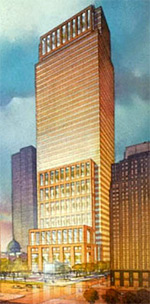 The seeds of what would become Comcast Center had just been planted as I watched the Philly Skyline grow larger as my Amtrak train pulled closer to my new home in
November 2000. When I first read about this a couple months later in the Inquirer, I was immediately intrigued. Neither Tyrone nor Shippensburg sprouted any
skyscrapers, so watching human power build something so massive was an entirely new concept for me. The entire process was fascinating to me: the recruitment of tenants,
the
redesigns and the redesigns of the redesigns, the political wrangling, the rumors and the controversy, the demolition and the construction.
The seeds of what would become Comcast Center had just been planted as I watched the Philly Skyline grow larger as my Amtrak train pulled closer to my new home in
November 2000. When I first read about this a couple months later in the Inquirer, I was immediately intrigued. Neither Tyrone nor Shippensburg sprouted any
skyscrapers, so watching human power build something so massive was an entirely new concept for me. The entire process was fascinating to me: the recruitment of tenants,
the
redesigns and the redesigns of the redesigns, the political wrangling, the rumors and the controversy, the demolition and the construction.
Of course in the time between reading I'd watch my first skyscraper rise and its groundbreaking four years later, I watched two other skyscrapers rise. As well, in
the time it took to build The St James and Cira
Centre, the 746' kasota stone clad One Pennsylvania Plaza had transformed into the 975' glass Comcast Center that would eclipse the spire atop Rouse's own One
Liberty Place by 30', its roof by nearly 100'. If you stacked Cira Centre on top of The St James, you'd still be two rowhomes short of matching this new tower's
height.
Liberty announced in January 2005 that Comcast had signed on as the lead tenant, and Governor Ed Rendell announced that a state grant would help commence
construction (ground solidly in the concept of public place, which the public may now see, in the forms of the extended Suburban Station concourse, the destination
plaza, and the stunning HDTV show). It was no small coincidence that phillyskyline.com stopped being an irregular image gallery and javascript playground, and came
together as the site you see now in February 2005. One of the first items of business was building the Cira
Centre construction progress section, which ultimately served as a template for all the sections that exist here today (Murano, Residences at the Ritz-Carlton,
10 Rittenhouse and The St James, which was retrofit to this format), but especially Comcast Center.
Since February 2005, when it was first introduced with a simple shot of D'Angelo Bros' digging equipment, the Comcast Center section of this site has grown as Comcast Center itself has grown. The tally is well over
4,000 photos when you factor in construction photos, Philly Skyline Philly Skyline wallpapers, four hard hat tours of the construction site, photos of the model,
progress diagrams, the topping off ceremony, the soft opening, Table 31's opening, and now the opening ceremony.
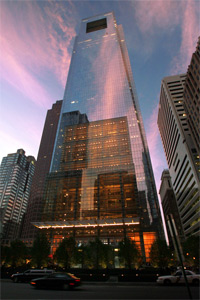 * * *
* * *
Friday, 6th June 2008 marked the opening ceremony of Comcast Center, officially capping three and a half years of construction and eight years of process. Friday,
6th June 2008 also marked the closing ceremony of Comcast Center on Philly Skyline, officially capping three and a half years of construction and eight years of
process.
With the final update of the Comcast Center section, I've -- as nearly as I can tell -- tied up all loose ends: the mouseover thingy in the Philly Skyline header
graphic has now completed construction. (Hi Stephen.) The construction diagram is also now complete. (I'm working on archiving past diagrams and making a time
lapse of it, since I didn't do one with photos.) And there are 47 new photos taken between June 1st and June 6th to close out the construction progress. (There
will probably be one more update after the underground marketplace officially opens next Monday.)
As corny as it sounds, I really did feel a connection to this building . . . watching the entire process coincide almost exactly with my experience in
Philadelphia, watching construction technique, watching it rise as the tallest green building in the entire country, a significant, forward thinking feat when you
consider the green movement has really only grown legs in the past few years. This connection peaked on Veterans Day last year: after shooting photos across the
city all day long, I went up to one of my favorite places in the world, the Belmont Plateau to check on the fall foliage of the giant maple tree on the hill. As a
photographer, I couldn't have asked for a better situation: the leaves were peak orange and red with thousands of them blanketing the ground below it, and the
skyline glowed in the late day sun. But with the Water Departmen's Ed Grusheski, who was also there enjoying the view, as my witness, it was Comcast Center that
made the whole vista shine.
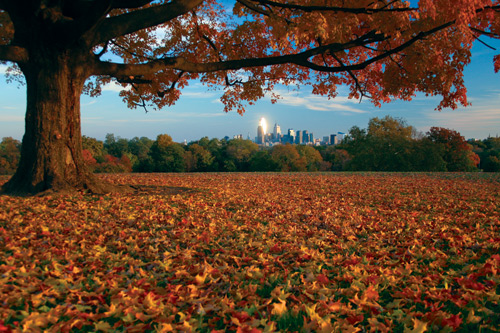
I have seen the sun glint off of buildings before and actually seek it out in the right photography conditions . . . but I had never seen an entire building
reflect the sun until 11/11/07 at the Plateau. If I was ever asked to pick out the best photo I've ever taken from the hundreds of thousands I've taken in my life,
it would probably be this one. (It's on the cover of the Philly Skyline, The Calendar: 2008 and is for
sale right now at 20" x 30" at Photolounge, more details of which will appear on this site later this week.)
Whether or not you like its architecture, it's hard to not appreciate the endless variations Comcast Center produces in different light, different weather,
different angles. I have, anyway.
And that's it. With the grand opening on Friday, Comcast Center has begun, so its spotlight on Philly Skyline has ended. Liberty's John Gattuso MC'd the ceremony
that included comments from his boss Bill Hankowsky, Councilman Darrell Clarke
(neither Mayor Michael Nutter nor Governor Ed Rendell was in attendance, which I found to be extremely weak), architect Bob Stern, Comcast founder Ralph Roberts,
and finally his son Brian, who introduced the Comcast Experience, the name for the much touted 80' x 20' HDTV show in the lobby. To his credit, he introduced it as
a "once in a lifetime chance to say thank you to Philadelphia," and concluded, "we are proud to call this city home."
It was a fitting comment to wrap things up . . . and, I guess I'll do the same. Though it sometimes falls into question, I too am proud to call this city home.
Even if you're an anti-TV luddite or anti-corporate-America rabble rouser, make it a point to go check out the Comcast Experience display. It is simply an
incredible feat of visual technology, and according to Brian Roberts, will be shown 18 hours a day, 7 days a week. Though there's never a doubt that one of the
world's most powerful corporations is privately tucked behind multiple layers of security upstairs, the ground level public spaces of Comcast Center are very
public and are meant to be used -- and enjoyed.
Regardless of your thoughts on politics, business, television, internet or architecture, you have to admit that pulling off the Comcast Center project, through
eight years of planning and collaboration from Liberty Property and Robert A.M. Stern Architects and Comcast and LF Driscoll and Olin Partnership and Motioneering
and Thornton Tomasetti and Quentin Thomas and Daroff Design and Kendall Heaton and CommerzLeasing and the Commonwealth of Pennsylvania and the City of Philadelphia
and many many more . . . well, it's pretty amazing.
From all of us at Philly Skyline, but especially me, thanks for the memories, Comcast Center.
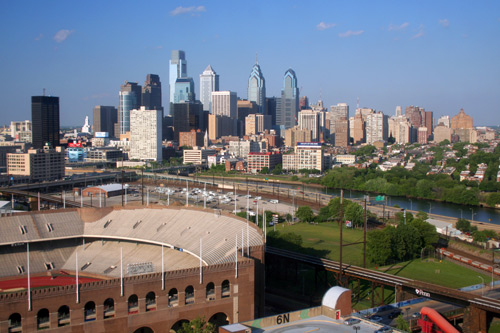
–B Love
|
